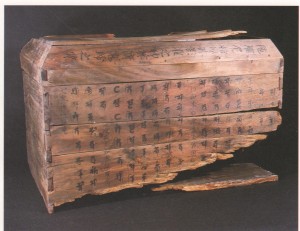Friday, November.11, 4:30 to 6:30pm, CWAC156
Word and Body, Dharani and the Buried: Tang Amulets and Liao Coffins
Dongshan Zhang,
Ph.D. Student, Art History, University of Chicago

There are a few different Chinese transliterations/translations of the word Dharani, including tuoluoni陀羅尼, ming明, zhou咒, miyu密語, and zhenyan真言. As incantations or spells, the dharani-s written in Chinese script are not sentences that conform to grammar. Nor is their religious efficacy achieved through the Buddhists’ grasping of their literal meaning. As the Liao-dynasty monk Daochen explains in xianmi yuantong chengfo xinyao ji (The Compendium of Essential Matters for the Heart of Unifying the Revealing and the Secret regarding Becoming Buddha):
“…that is why people say that zhou are the secret laws of buddhas. They transmit between buddhas and do not communicate to others. (Therefore, as ordinary people, we) should only recite and uphold them, and need not to scrape through the meaning. ”
“…謂呪是諸佛密法。佛佛相傳不通他解。但當誦持不須強釋。”
In this light, as words, the form of dharani is more important than the textual content. There are two ways to understand the form of dharani. Firstly, as spoken words, people would generate sound when they recite dharani-s. The Chinese translations of dharani, zhenyan, or miyu, clearly show how essential the auditory form is to dharani. However, due to the elaborate work done on this by many scholars, I will not spend much time in this regard. My focus is the form in the other sense: as written words, the visual forms that dharani presents.
In the first half of the presentation, we will examine several so-called dharani amulets excavated from tombs dated to as early as 8th century, and as late as 10th century. The paper amulets, whose dharani inscriptions display visual forms of high complexity, are essentially attempts to reconstruct the three-dimensional mandala-altars on two-dimensional surfaces.
The second half of the presentation will compare dharani amulets to the coffins bearing dharani inscriptions over the surfaces from the Liao-dynasty tombs in Xuanhua.
I will argue that the Xuanhua dharani coffins are attempts of a “backward transformation”: their makers took elements from the mandala-altars on two-dimensional amulets and transformed the coffins into three-dimensional mandalas.
Friday, Nov. 11, 4:30 to 6:30pm, CWAC156
Persons with concerns regarding accessibility please contact Yunfei Shao(yunfeishao@uchicago.edu) or Zhiyan Yang (zhiyan@uchicago.edu)